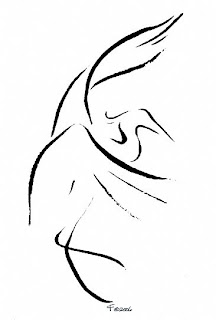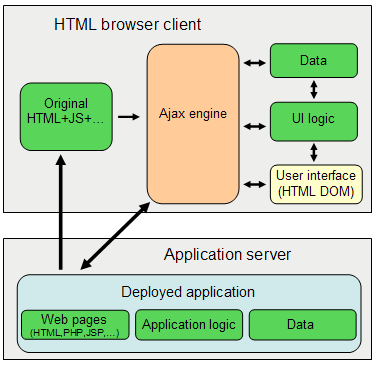(Revised May. 25, 2008)
 Quality is a characteristic property that defines the apparent individual nature of something. The last corollary tells that the Web evolution stages can be measured by quality. Now we are going to resolve what the particular qualities are.
Quality is a characteristic property that defines the apparent individual nature of something. The last corollary tells that the Web evolution stages can be measured by quality. Now we are going to resolve what the particular qualities are.
Corollary 3: the quality measurement of characteristic variables of Web evolution can be defined analogously to the quality measurement of the respective characteristic variables of human growth.
This corollary is obtained from the Corollary 1 and Corollary 2. Since every evolutionary stage of the Web can be well mapped to a particular stage of human growth, we can certainly define the measurement methods for Web evolution in an analogous way of defining the measurement methods for human growth. The two varied evolutionary procedures, however, share a mapping of their quality evaluation methodology.
Three Basic Types of Web Resources
Based on the discussion of three basic evolutionary elements of WWW, Web resources have three basic types---the descriptive type (static content, data resources), the functional type (dynamic behavior, service resources), and the interconnective type (interconnective link, link resources). The three resource types are mutually independent to each other. A data resource can exist without being used by any service and connected by any link; a service resource can exist without having any data and being connected by any link; a link resource can exist without being used to connect any other resources. Because of this fact, we need to have varied quality and quantity measurement for each of the individual type of Web resources.
Based on the Corollary 3, we can map the three types of web resources (descriptive, functional, and interconnective) to three characteristic variables that measure the growth of human---personality, capability, and interpersonal relationship. To simplify our presentation, we substitute "interpersonal relationship" by "friendship" in the future discussion. In particular, personality of human is descriptive type and hence it maps to data resource on the web; capability of human is functional type and hence it maps to service resource on the web; and friendship of human is interconnective type and hence it maps to link resource on the web. We will justify these mappings in more details shortly later. By these mappings, we can analogically define the quality and quantity measurements of Web evolution on the basis of the quality and quantity measurements of human growth.
Two Fundamental Views about Quality Measurements
There are two fundamental views when measuring human growth---the individual point of view and the community point of view. By the individual point of view, a person grows up by improving the qualities of personality, capability, and friendship himself. By the community point of view, however, a person's growth is about the person's incrementally taking (and producing) varied resources from (and for) a community. Within a particular stage of one's growth, a person takes (and produces) certain quality of resources from (and for) community by quantity. Within a transitional period of one's growth (i.e. one grows up from a lower stage to an upper stage, e.g., growing up from newborn to pre-school), however, the person suddenly gains the ability to take (and produce) resources of a higher quality from (and for) community. By the Corollary 1, Web evolution can be measured in the same way.
Quality and Quantity Measurements of Human Growth
 Measurements of Personality
Measurements of Personality
From the individual point of view, personality is the complex of all the attributes that characterizes a unique individual. For example, a person's personality is a complex of his emotion, knowledge, customs, etc.
From the community point of view, however, every personal attribute is a descriptive resource that belongs to a community. For example, my emotion and knowledge are resources of the community I participate. They are the resources that are consumable by the other community members (certainly, however, including myself). By this community view, there is a clear mapping between human personality and Web data resource.
By the community point of view, the personality of a person is a unique, personalized subset of descriptive community resources. In terms of humans' growth, this definition describes a measurement of quantity and quality about personality.
The quantity of a personality is measured by the amount of descriptive community resources the personality possesses. For example, from the individual point of view John learns more knowledge. This is, however, equivalent to say that John possesses greater quantity of shared knowledge resources from a community. From the individual point of view Peter thinks of a new theory. This is equivalent to say that Peter has produced a new knowledge resource for community. Moreover, Peter automatically possesses the new resource by having produced it himself.
The quality of a personality is measured by the highest quality of one's possessed descriptive resources. The quality of a descriptive resource is then measured by the degree of productiveness the resource supports when it is used. More productive descriptive resources are with higher quality. For example, between patience and impatience the former one is a higher quality personality resource and the latter one is a lower quality personality resource. Impatience is generally less helpful for producing more valuable community resources. On the contrary, patience is a high quality resource that is preferred by community for more resource production. In similar, impatience is a personality resource we have with us when we were born. But patience is a personality resource we obtain when we grow up.
 Measurements of Capability
Measurements of Capability
From the individual point of view, capability is the ability to execute a specified course of action. For example, Alice can knit; knitting is a capability of Alice.
From the community point of view, every personal ability is a functional resource of a community. A functional resource is a resource that may consume the other community resources and produce. For example, Alice owns the functional resource of knitting, which consumes community resources such as Alice's labor and patience, and eventually produces product such as sweater. By this community view, there is a clear mapping between human capability and Web service resource.
By the community view, the capability of a person is a unique, personalized subset of functional community resources. In terms of humans' growth, this definition presents a measurement of quantity and quality about capability.
The quantity of a capability is measured by the amount of functional community resources the capability possesses. For example, from the individual point of view Alice learns more capabilities. This is equivalent to say that Alice possesses greater quantity of functional resources from a community.
The quality of a capability is measured by the highest quality of its possessed functional resources. The quality of a functional resource is then measured by how much initiative the functional resource is when consuming community resources (of any type). The functional resources with greater initiative have higher quality. For example, Alice can clean room by being asked to do it. This passive house-cleaning capability is with low quality. By contrast, Mary actively clean room without being asked. This active house-cleaning capability is with high quality. Again, we see that the active capabilities are not born-with but requiring people to grow up to certain age to obtain.
 Measurements of Friendship
Measurements of Friendship
From the individual point of view, friendship is the connections of a person to the other persons in a society.
From the community point of view, every connection among persons is an interpersonal resource. Hence we also see a clear mapping between human friendship and Web link resources.
By the community view, the friendship of a person is a unique, personalized subset of interpersonal community resources. In terms of humans' growth, this definition presents a measurement of quantity and quality about friendships.
The quantity of a friendship is measured by the number of interpersonal community resources the friendship possesses. For example, from the individual point of view Peter makes more friends. This is equivalent to say that Peter possesses more interpersonal resources from community.
The quality of a friendship is measured by the highest quality of its possessed interpersonal community resources. The quality of a interpersonal resource is measured by how vulnerable its connection is. The less vulnerable connections have higher quality. For example, the friendships between pre-school kids are generally with less quality than the friendships between college students. The friendships between pre-school kids are built upon loose foundation, such as they are living in the same neighborhood and have attended the same school. But the friendships between college students are built upon much stronger foundation such as common interest and beliefs (e.g., the common interest of classic music and the common belief of pursuing democracy). In comparison, the friendships of the former type are more vulnerable to the change of external environment than the ones of the latter type.
 Quality Measurements of Web Evolution
Quality Measurements of Web Evolution
By carefully define the quality measurements of human growth, by the Corollary 3 we can analogically define the quality measurements of Web evolution.
(1) The quality of a data resource is measured by the degree of productiveness the data resource has when it is used by the public. For example, the Web-1.0-quality data resources are raw data without labels; the Web-2.0-quality data resources are human-tagged data. Hence Web-2.0 data resources have higher quality than Web-1.0 data resources have because they are more useful for production.
(2) The quality of a service resource is measured by the degree of initiativity this service resource has when consuming Web resources (which could include itself). For example, the Web-1.0-quality service resources are passive (or reactive) and non-portable; the Web-2.0-quality service resources are active and portable. Hence Web-2.0 service resources have higher quality than Web-1.0 service resources have because they are more initiative to do their work.
(3) The quality of a link resource is measured by the degree of vulnerability the link resource has. For example, the Web-1.0-quality link resources are hardcoded and each of them links between only two nodes; the Web-2.0-quality link resources are labeled and each of them simultaneously connects many nodes. Hence Web-2.0 link resources have higher quality because it is much more difficult to totally delete them from the Web (they are less vulnerable).
Final Address
The Corollary 3 is actually a general methodology for studying the progress of Web evolution. A difficult of Web evolution research with respect to others such as natural evolution is that the Web is too new to have long history for us to study. This is why the analogical methodology become particularly useful and helpful. Without a fair reference, the research of Web evolution might simply be trapped into fortune-telling. However, from Corollary 1 to Corollary 3 we declared a scientific methodology that can lead the research of Web evolution into a formal track. This is a standard scientific way to study events that will happen but not happen yet.
The next: Trigger of Transition

























